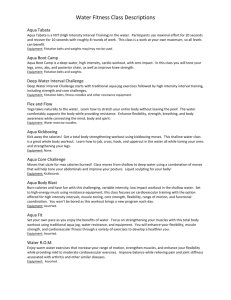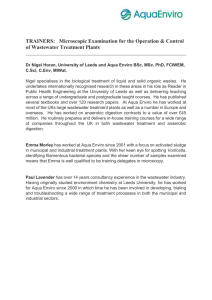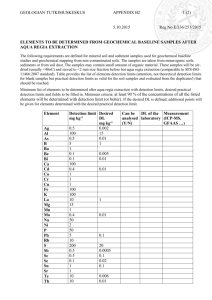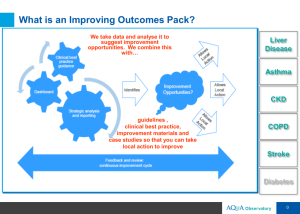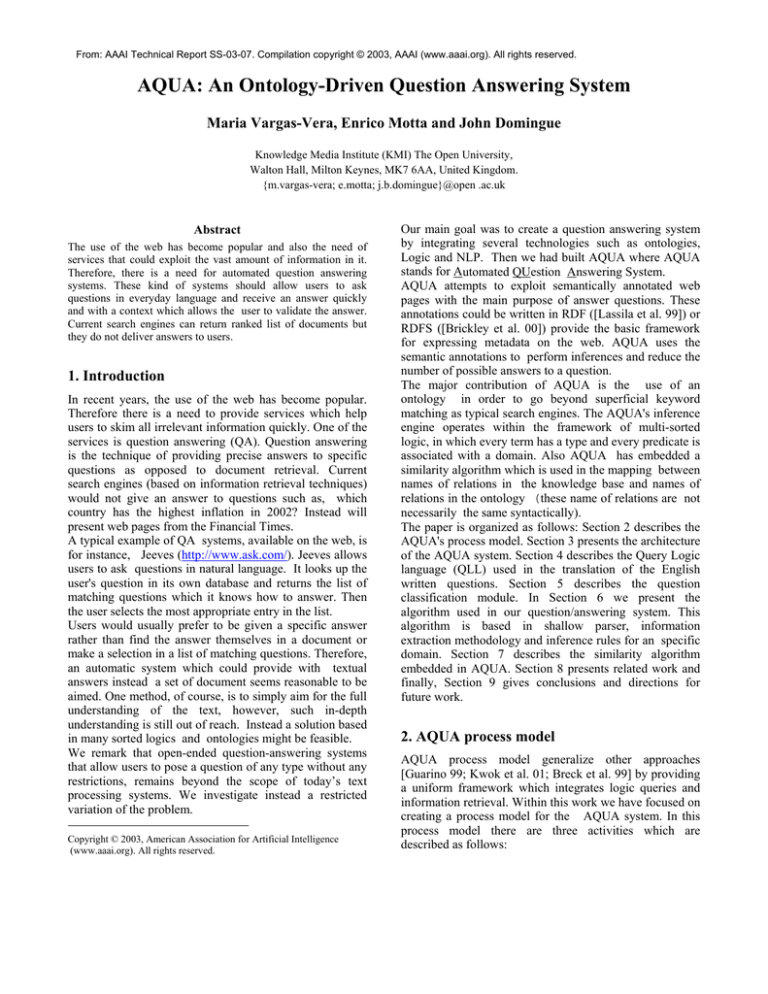
From: AAAI Technical Report SS-03-07. Compilation copyright © 2003, AAAI (www.aaai.org). All rights reserved.
AQUA: An Ontology-Driven Question Answering System
Maria Vargas-Vera, Enrico Motta and John Domingue
Knowledge Media Institute (KMI) The Open University,
Walton Hall, Milton Keynes, MK7 6AA, United Kingdom.
{m.vargas-vera; e.motta; j.b.domingue}@open .ac.uk
Abstract
The use of the web has become popular and also the need of
services that could exploit the vast amount of information in it.
Therefore, there is a need for automated question answering
systems. These kind of systems should allow users to ask
questions in everyday language and receive an answer quickly
and with a context which allows the user to validate the answer.
Current search engines can return ranked list of documents but
they do not deliver answers to users.
1. Introduction
In recent years, the use of the web has become popular.
Therefore there is a need to provide services which help
users to skim all irrelevant information quickly. One of the
services is question answering (QA). Question answering
is the technique of providing precise answers to specific
questions as opposed to document retrieval. Current
search engines (based on information retrieval techniques)
would not give an answer to questions such as, which
country has the highest inflation in 2002? Instead will
present web pages from the Financial Times.
A typical example of QA systems, available on the web, is
for instance, Jeeves (http://www.ask.com/). Jeeves allows
users to ask questions in natural language. It looks up the
user's question in its own database and returns the list of
matching questions which it knows how to answer. Then
the user selects the most appropriate entry in the list.
Users would usually prefer to be given a specific answer
rather than find the answer themselves in a document or
make a selection in a list of matching questions. Therefore,
an automatic system which could provide with textual
answers instead a set of document seems reasonable to be
aimed. One method, of course, is to simply aim for the full
understanding of the text, however, such in-depth
understanding is still out of reach. Instead a solution based
in many sorted logics and ontologies might be feasible.
We remark that open-ended question-answering systems
that allow users to pose a question of any type without any
restrictions, remains beyond the scope of today’s text
processing systems. We investigate instead a restricted
variation of the problem.
Copyright © 2003, American Association for Artificial Intelligence
(www.aaai.org). All rights reserved.
Our main goal was to create a question answering system
by integrating several technologies such as ontologies,
Logic and NLP. Then we had built AQUA where AQUA
stands for Automated QUestion Answering System.
AQUA attempts to exploit semantically annotated web
pages with the main purpose of answer questions. These
annotations could be written in RDF ([Lassila et al. 99]) or
RDFS ([Brickley et al. 00]) provide the basic framework
for expressing metadata on the web. AQUA uses the
semantic annotations to perform inferences and reduce the
number of possible answers to a question.
The major contribution of AQUA is the use of an
ontology in order to go beyond superficial keyword
matching as typical search engines. The AQUA's inference
engine operates within the framework of multi-sorted
logic, in which every term has a type and every predicate is
associated with a domain. Also AQUA has embedded a
similarity algorithm which is used in the mapping between
names of relations in the knowledge base and names of
relations in the ontology (these name of relations are not
necessarily the same syntactically).
The paper is organized as follows: Section 2 describes the
AQUA's process model. Section 3 presents the architecture
of the AQUA system. Section 4 describes the Query Logic
language (QLL) used in the translation of the English
written questions. Section 5 describes the question
classification module. In Section 6 we present the
algorithm used in our question/answering system. This
algorithm is based in shallow parser, information
extraction methodology and inference rules for an specific
domain. Section 7 describes the similarity algorithm
embedded in AQUA. Section 8 presents related work and
finally, Section 9 gives conclusions and directions for
future work.
2. AQUA process model
AQUA process model generalize other approaches
[Guarino 99; Kwok et al. 01; Breck et al. 99] by providing
a uniform framework which integrates logic queries and
information retrieval. Within this work we have focused on
creating a process model for the AQUA system. In this
process model there are three activities which are
described as follows:
Question processing. The Question processing is
performed in order to understand the question asked by the
user. This ''understanding'' of the question requires several
steps such as parse the question, representation of the
question and classification of the question on one of
the following types: what, who, when, which why and
where.
Document Processing. Document processing relies on the
extraction of the focus of the question. Then a set of
document is selected and a set of paragraphs are extracted.
Answer processing. Answers are extracted and validated
using the information of type of expected answer and then
questions are scored.
A detailed architecture of the AQUA system is described
in the next section. This architecture has embedded the
process model outlined in this section.
3. The AQUA architecture
Figure 1 shows the ideal architecture of our AQUA
system. Each module in the architecture is described as
follows:
8. Question classification & reformulation classifies
question as belonging to any of the types supported in
AQUA (what, who, when, which, why and where).
9. Search query formulation. In this module we
transform the original question using transformation rules
into a new question Q'. At this stage synonymous words
are used, punctuation symbols are removed and words are
stemmed.
10. Search engine searches in the web for a set of
documents which satisfy the query using a selected set of
keywords.
11. Answer extraction extracts information from the set
of documents that the search engine found satisfying the
question Q'.
12. Answer selection it has three functionalities. It clusters
answers, scores them using the voting model and finally it
obtains a final ballot.
We could identify the three processes described in section
2. Steps 1-8 correspond to question processing. Steps 9-10
correspond to the document processing and steps 11-12
correspond to the answer processing.
1. Query interface. The user writes a question using the
user interface. This query interface is a Google sort type
interface. If the user does not obtain a satisfactory answer
then he/she could reformulate the query.
2. The NLP parser does the segmentation of the sentence
into subject, verbs, prepositional phrases, adjectives and
objects. The output of this module is the logic
representation of the query.
3. WordNet. It is used as dictionary in the AQUA system.
4. Ontology. We use a hand-crafted ontology containing
people, projects, publications, technologies and events.
5. Knowledge base. This knowledge base is constructed
incrementally and it is domain specific. In our case is
knowledge base containing information about our
organization such as researchers, projects, publications,
technologies and events happening in our institute.
6. Interpreter is the logic interpreter which executes a
query using unification and resolution algorithms. It finds
a proof of the query against the knowledge base.
7. Failure analysis. This subsystem analyzes the failure of
a given question and gives an explanation why the query
failed. Then the user could provide new information for
the proof. At this point the proof could be re-assume. This
process could be repeated several times as is needed.
Figure 1. The AQUA architecture
4. Question Logic Language (QLL)
QLL is a query logic language which could be used to
express questions about a specific domain. It contains
terms in the Prolog sense and these could be defined
inductively [Clocksin 81]. The logic language has
embedded type definitions for each variable and type for
each predicates. QLL is a subset of Prolog. Therefore, the
semantics of QLL is weaker than the Prolog semantics. For
a full semantics of Prolog refers to [Lloyd 84]. Note that
only variables, atoms, and certain forms of terms might
appear as arguments of a QLL predicate.
The translation between a query written in English and a
logical form is performed using the following rules of
translation. The form of the logical predicates introduced
by each syntax category is described as follows:
1. Nouns (without complement) introduce a predicate of
arity 1. For example the noun capital could introduce the
predicate capital(X) restricting that the type of X is the
name of a city.
2. Nouns (with complement) introduce a predicate of arity
the number of complements plus one. The pattern is
predicate_name(argument1, ..., argumentN). For example,
in the question what is the population of the UK? the noun
population gets translated in the predicate population(uk,
X).
3. Qualitative adjectives introduces a predicate of arity 1.
The pattern is predicate_name(argument). For example, the
adjective European Community
translates into
european(X).
4. Quantitative adjectives introduces a binary predicates.
The pattern is the following:
predicate_name(argument_1, argument_2). For example,
the question how big is London? translates into the
following predicate: has-size(london, Y).
5. Prepositions introduce a binary predicate. The pattern is
as follows:
name_preposition(argument_1, argument_2). For
example, la preposition between gets translated in the
predicate between(X,Y).
6. Verbs introduce predicates with one or more arguments.
The first argument should be the subject of the verb and
the second is the direct object, the third is the indirect
object (if any) and complements (if any). For example,
when does lord Putmann visited KMi? is translated in the
following predicate: visited(lord_putmann,kmi).
7. A set of built-in predicates is also available in our QLL
language.
5. Questions types
This phase involves processing the query to identify the
category of answer that the user is seeking. The
classification is performed using the information obtained
during the segmentation of the sentence. During sentence's
segmentation the system finds nouns, verbs, prepositions
and adjectives. The category of a desired answers are listed
below.
what/which - this kind of questions appear with a head
noun that describes the category of the entity involved. For
this category the head noun is extracted and WordNet is
used to perform the mapping between head noun and
category.
who, whom - the category of the answer is person.
when - the category of the answer is date.
why - the category of the answer should be a reason.
where - the category of the answer is location.
The range of answers of a question answering system
varies from yes/no answers, true/false questions, and
questions which could be answered with a word or a
sentence. In some cases questions could have more than
one answer, whilst in other cases the system might not
find the answer.
6. AQUA algorithm
The classification information is giving information about
the kind of answer that we should expect to achieve as an
answer. Therefore we could anticipate the type of answer
that the system will produce. For example, if we ask what
is the capital of Mexico? we know that in the answer is
almost certainly the name of a city.
The main algorithm implemented in our AQUA system
consists of the following steps:
Algorithm
1. To provide the question Q.
2. To parse the question in its grammatical components.
3. To translate the English question into a logic formulae.
4. To execute the logic formulae against the knowledge
base. if succeed then provide an answer and go to step 5.
if not then
To classify question in one of the following types:
what - specification of objects, activity definition
who - person specification
when - date
which - specification of objects, attributes
why - justification of reasons
where - geographical location
To transform the query Q into a new query Q'.
To launch a search engine with the new question Q'
To analyze retrieved documents which satisfy the query
Q'.
To perform answer extraction
To perform answer selection
5. Stop
7. Algorithm for concept and relation
similarity
The success of a query evaluation depends on a good
mapping between the names of relations used in the user’s
query and names of relations used in the knowledge base.
AQUA has embedded a similarity algorithm which provide
alternative names of relations. Our similarity algorithm is
defined using Dice coefficient [Frakes et al. 92] and
WordNet. It uses a graph containing a subset of the
ontology (with the relevant concepts to the query) and the
graph obtained from the query. The output is the degree of
similarity between concepts/relations and the alternative
relation name. If similarity is below a given threshold then
AQUA provides synsets from Wordnet and the user should
select one sense of the synsets offered.
The mapping between names in the knowledge base and
the query was one of the major problems that we
encountered in the design of the AQUA system.
8. Related work
In this section we describe several systems related to the
AQUA system.
MULDER is a web QA system related to our work [Kwok
et al. 01]. Mulder extracts snippets called summaries and
generates a list of candidate answers. However, the system
does not have an inference mechanism embedded such as
the use of semantic relations defined in an ontology like in
the AQUA system.
QANDA is closest to AQUA in spirit and functionality.
QUANDA takes questions expressed in English and
attempts to provide a short and concise answer (a noun
phrase or sentence) [Breck et al. 99]. QANDA is a
Question Answering system which combines knowledge
representation, information retrieval and natural language
processing. A question is represented as first order logic
expression. Also knowledge representation techniques are
used to represent questions and concepts discussed in the
documents. However, QUANDA does not use ontological
relations and domain specific axioms like in AQUA.
Ontoseek is a information retrieval system coupled with an
ontology [Guarino 99]. Ontoseek performs retrieval based
on content instead of string based retrieval. The target was
the information retrieval with the aim of improving recall
and precision and the focus was to specific classes of
information repositories yellow pages and product
catalogues. The Ontoseek system provides interactive
assistance on query formulation generalization an
specialization. Queries are represented as conceptual
graphs then according with the authors ''the problem is
reduced to ontology driven graph matching where
individual node and arcs match if the ontology indicates
that a subsumption relation holds between them''. These
graphs are not constructed automatically. The Ontoseek
team developed a semi-automatic approach in which the
user has to verify the links between different nodes in the
graph via designated user-interface.
9. Conclusions
We had developed a question answering system called
AQUA. AQUA uses NLP technology, Logic and an
hand-crafted ontology. The main goal of AQUA is to find
a textual answer to the question in a short period of time.
The first implementation of AQUA answers questions
about KMi domain because we had coupled AQUA with
the KMi ontology which consists of people, projects,
publications and
events. However, in future
implementation we plan to provide an answers in different
domains by coupling AQUA with other ontologies. We
had discussed a similarity algorithm embedded in AQUA
using and Dice coefficient and WordNet. This algorithm
is used by AQUA to ensure that the question does not fail
because there is a mismatch between names of relations in
the knowledge base and the user query. Finally, as future
work we will explore how automatically extract inference
rules since knowledge about inference relations between
natural language expressions is very important for the
question answering problem.
Acknowledgements
This work was funded by the Advanced Knowledge
Technologies (AKT), which is sponsored by the UK
Engineering and Physical Sciences Research Council.
References
Breck E., and House D. and Light M., and Mani I.
Question Answering from Large Document
Collections, AAAI Fall Symposium on Question
Answering Systems, 1999.
Brickley D., and Guha R. Resource Description
Framework
(RDF) Schema Specification 1.0.,World Web
Consortium,2000.URL:http://www.w3.org/TR/2000/C
R-rdf-schema 20000327.
Clocksin W. F. and Mellish C. S. Programming in
Prolog. Springer-Verlag, 1981.
Frakes W., and Baeza-Yates R. Information Retrieval:
Data Structures & Algorithms, Prentice Hall, 1992.
Guarino N. OntoSeek: Content-Based Acess to the Web,
IEEE Intelligent Systems, pp 70-80,1999.
Katz B. From sentence processing to information access
on the world wide web, Proceedings of AAAI
Symposium on Natural Language Processing for the
World Wide Web, 1997.
Kwok C., and Etzioni O., and Weld D.S. Scaling
Question Answering to the Web, World Wide Web,
pp 150-161, 2001.
Lassila O., and Swick R.Resource Description
Framework (RDF): Model and Syntax Specification.
World Wide Web Consortium, 1999.
URL:http://www.w3.org/TR/REC-rdf-syntax/.
Lloyd J. W. Foundations of Logic Programming,
Springer-Verlag, 1984.

